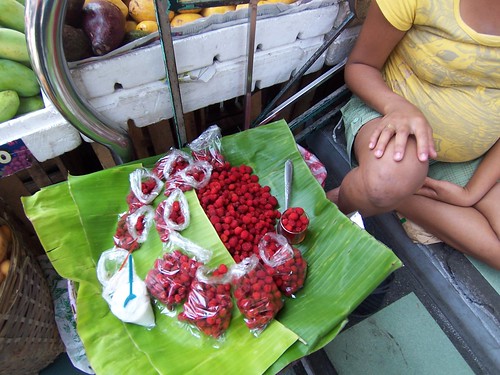Glossary S
Sous Vide refers to the French culinary term which means "under vacuum" is a cooking method in which fresh ingredients are cooked in air tight (vacuum-sealed) plastic bags in hot water. The food maintains maximum flavor since it is slow cooked for an extensive period of time (over 24 hours) at a relatively low temperature since the water is well below boiling point which is approximately 60°C.
This cooking technique was first developed by French chef Georges Pralus, who discovered that cooking foie gras in this way kept it from shrinking and losing fat content. Some health experts though, believe that cooking using the method "Sous Vide" is dangerous since the food remains below the "danger zone" of 140?F wherein bacteria can multiply. Food cooked "Sous Vide" is typically tender, flavorful and moist.
Sampinit a red fruit being sold in San Pablo City, Laguna market in March so probably they are available during summer months, the seller said it is called "Raspberries" in English.
Sampinit is also called Sapinit and Tungaw-Tungaw. It is a Wild Raspberry (Rubus rosifolius Linn.) which said to grow in the wild and bushes. The fruits can be harvested when ripe and eaten fresh. In San Pablo City Market, the fresh fruits are sold with a small pack of salt or with salt. The fruits can also be processed or made into jams, wine and juice. The fruit has a tangy strawberry taste
Sampinit fruit is said to be good source of phythochemicals that helps fight the growth of cancer cells and development of Alzheimer's.
This exotic fruit is too rare. I have visited a lot of Wet markets (Palengke) around the Philippines and I only saw them sold in San Pablo City Market in Laguna. Unfortunately, I do not dare to taste fruits which is too foreign to me, especially when the weather is too hot.
Raspberries is also called in Filipino as Prambuwesas.

This Filipino (Tagalog) song talks about a native Filipino house/hut (Bahay Kubo) and the vegetables planted around it. I posted it, as it is a beautiful song about the lifestyle of some Filipinos in the rural areas still living in native houses and still planting vegetables around.I always remember my childhood and my grandfather when I sing this song.
Bahay Kubo
Bahay kubo,
kahit munti
Ang halaman doon
ay sari-sari
Singkamas at talong
Sigarilyas at mani
Sitaw, bataw, patani
Kundol, patola,
upo't kalabasa
at saka meron pang
Labanos, mustasa
Sibuyas, kamatis
Bawang at luya
Sa paligid ligid
ay puno ng linga.
It is all about a native hut surrounded by vegetable plants like turnip, eggplant, winged beans, peanuts, different kind of beans, luffa, gourd, onions, tomatoes, garlic, ginger and many other vegetable plants, including sesame seeds
